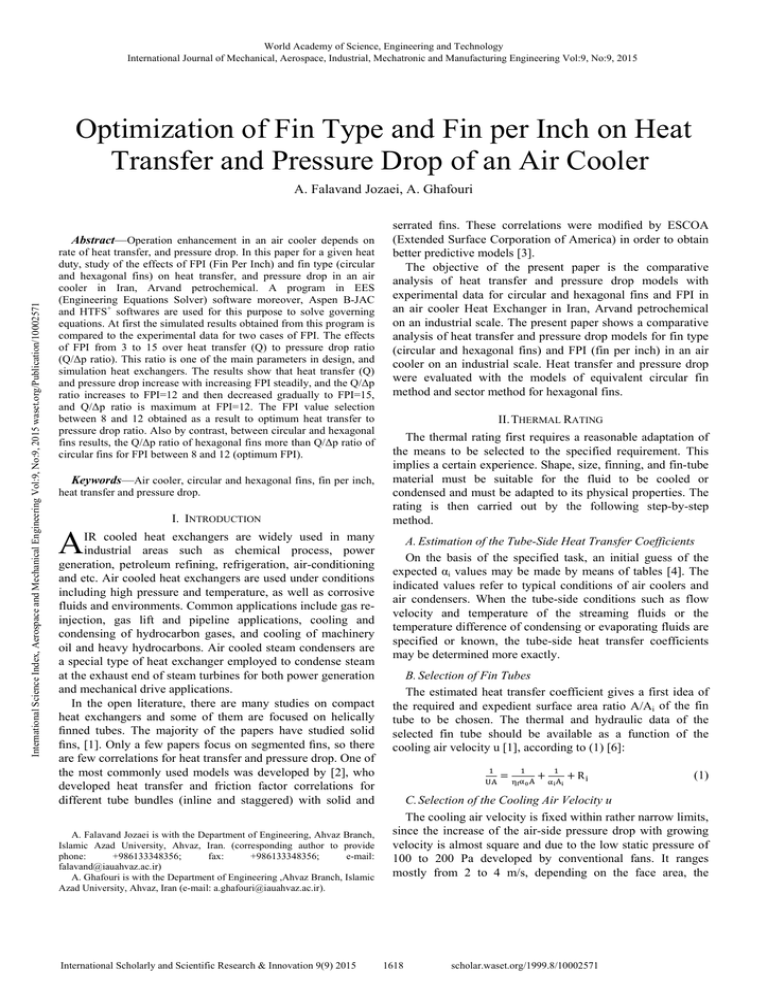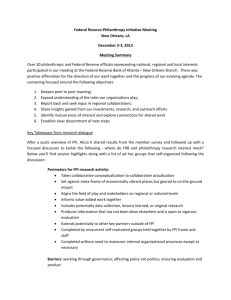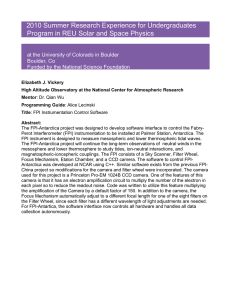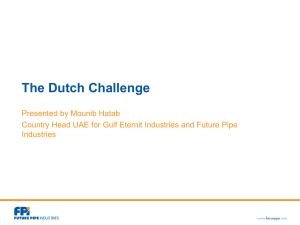Optimization of Fin Type and Fin per Inch on Heat Transfer and
advertisement

World Academy of Science, Engineering and Technology International Journal of Mechanical, Aerospace, Industrial, Mechatronic and Manufacturing Engineering Vol:9, No:9, 2015 Optimization of Fin Type and Fin per Inch on Heat Transfer and Pressure Drop of an Air Cooler A. Falavand Jozaei, A. Ghafouri International Science Index, Aerospace and Mechanical Engineering Vol:9, No:9, 2015 waset.org/Publication/10002571 Abstract—Operation enhancement in an air cooler depends on rate of heat transfer, and pressure drop. In this paper for a given heat duty, study of the effects of FPI (Fin Per Inch) and fin type (circular and hexagonal fins) on heat transfer, and pressure drop in an air cooler in Iran, Arvand petrochemical. A program in EES (Engineering Equations Solver) software moreover, Aspen B-JAC and HTFS+ softwares are used for this purpose to solve governing equations. At first the simulated results obtained from this program is compared to the experimental data for two cases of FPI. The effects of FPI from 3 to 15 over heat transfer (Q) to pressure drop ratio (Q/Δp ratio). This ratio is one of the main parameters in design, and simulation heat exchangers. The results show that heat transfer (Q) and pressure drop increase with increasing FPI steadily, and the Q/Δp ratio increases to FPI=12 and then decreased gradually to FPI=15, and Q/Δp ratio is maximum at FPI=12. The FPI value selection between 8 and 12 obtained as a result to optimum heat transfer to pressure drop ratio. Also by contrast, between circular and hexagonal fins results, the Q/Δp ratio of hexagonal fins more than Q/Δp ratio of circular fins for FPI between 8 and 12 (optimum FPI). Keywords—Air cooler, circular and hexagonal fins, fin per inch, heat transfer and pressure drop. A I. INTRODUCTION IR cooled heat exchangers are widely used in many industrial areas such as chemical process, power generation, petroleum refining, refrigeration, air-conditioning and etc. Air cooled heat exchangers are used under conditions including high pressure and temperature, as well as corrosive fluids and environments. Common applications include gas reinjection, gas lift and pipeline applications, cooling and condensing of hydrocarbon gases, and cooling of machinery oil and heavy hydrocarbons. Air cooled steam condensers are a special type of heat exchanger employed to condense steam at the exhaust end of steam turbines for both power generation and mechanical drive applications. In the open literature, there are many studies on compact heat exchangers and some of them are focused on helically finned tubes. The majority of the papers have studied solid fins, [1]. Only a few papers focus on segmented fins, so there are few correlations for heat transfer and pressure drop. One of the most commonly used models was developed by [2], who developed heat transfer and friction factor correlations for different tube bundles (inline and staggered) with solid and A. Falavand Jozaei is with the Department of Engineering, Ahvaz Branch, Islamic Azad University, Ahvaz, Iran. (corresponding author to provide phone: +986133348356; fax: +986133348356; e-mail: falavand@iauahvaz.ac.ir) A. Ghafouri is with the Department of Engineering ,Ahvaz Branch, Islamic Azad University, Ahvaz, Iran (e-mail: a.ghafouri@iauahvaz.ac.ir). International Scholarly and Scientific Research & Innovation 9(9) 2015 serrated fins. These correlations were modified by ESCOA (Extended Surface Corporation of America) in order to obtain better predictive models [3]. The objective of the present paper is the comparative analysis of heat transfer and pressure drop models with experimental data for circular and hexagonal fins and FPI in an air cooler Heat Exchanger in Iran, Arvand petrochemical on an industrial scale. The present paper shows a comparative analysis of heat transfer and pressure drop models for fin type (circular and hexagonal fins) and FPI (fin per inch) in an air cooler on an industrial scale. Heat transfer and pressure drop were evaluated with the models of equivalent circular fin method and sector method for hexagonal fins. II. THERMAL RATING The thermal rating first requires a reasonable adaptation of the means to be selected to the specified requirement. This implies a certain experience. Shape, size, finning, and fin-tube material must be suitable for the fluid to be cooled or condensed and must be adapted to its physical properties. The rating is then carried out by the following step-by-step method. A. Estimation of the Tube-Side Heat Transfer Coefficients On the basis of the specified task, an initial guess of the expected αi values may be made by means of tables [4]. The indicated values refer to typical conditions of air coolers and air condensers. When the tube-side conditions such as flow velocity and temperature of the streaming fluids or the temperature difference of condensing or evaporating fluids are specified or known, the tube-side heat transfer coefficients may be determined more exactly. B. Selection of Fin Tubes The estimated heat transfer coefficient gives a first idea of the required and expedient surface area ratio A/Ai of the fin tube to be chosen. The thermal and hydraulic data of the selected fin tube should be available as a function of the cooling air velocity u [1], according to (1) [6]: R (1) C. Selection of the Cooling Air Velocity u The cooling air velocity is fixed within rather narrow limits, since the increase of the air-side pressure drop with growing velocity is almost square and due to the low static pressure of 100 to 200 Pa developed by conventional fans. It ranges mostly from 2 to 4 m/s, depending on the face area, the 1618 scholar.waset.org/1999.8/10002571 World Academy of Science, Engineering and Technology International Journal of Mechanical, Aerospace, Industrial, Mechatronic and Manufacturing Engineering Vol:9, No:9, 2015 number of tube rows n, and on the admissible and feasible temperature rise of the cooling air. D. Overall Heat Transfer Coefficient U After the αi value and the cooling air velocity have been determined, the overall heat transfer coefficient for a selected fin-tube system may be obtained from (1), when an additional product-side fouling rfoul needs to be taken into account, the actual service value is first determined, then: International Science Index, Aerospace and Mechanical Engineering Vol:9, No:9, 2015 waset.org/Publication/10002571 (2) The fouling resistance rfoul may be taken from pertinent manuals or gotten from experience. Generally, air-side fouling need not be considered for the U value. Although relatively high air-side fouling may adversely affect the air flow through the unit and thus decrease the effective temperature difference, it scarcely influences the U value because of the relatively small air-side heat flux. E. Number of Tube Rows The number of tube rows needed depends on both the specific requirement and the efficiency of the selected fin-tube system. Roughly estimated, these two factors can be expressed by a quantity a, which includes the temperature difference between product and cooling air inlet as well as the value U(A/S) of the fin tube[4]. , ∆ , / (3) / where C1 = 24 for fin tubes of the kind, C2 = 0.49 F. Product Thermal Number One auxiliary term for the further thermal rating is the dimensionless number , ∆ , , , (5) It is used later to determine the effective mean temperature difference (EMTD) and the surface area needed. G. Coolant Design Number The dimensionless design number applicable for one tube row is now calculated on the basis of the available results. / (6) where cP is the specific heat of air at constant pressure. H. NTU Number The dimensionless NTU number (number of transfer units) is obtained by the product of the coolant design number and the number of tube rows: ∆ I. Coolant Thermal Number ∆ /∆ for various The dimensionless value types of flow in air coolers is given in [5]. For three typical flow arrangements with air coolers: cross flow; cross-counter flow return bend; counter flow), is given by (8), (9), and (11). Besides the known quantity NTU, the equations also contain the quantity ∆ /∆ , which must first be estimated in order to obtain generally lies between 0 and 1, but may also be higher. For isothermal condensation, ∆ and are zero, so the same is obtained for all flow types. Arrangement I: Cross Flow On the tube side, one or more passes, side by side: (8) Arrangement 2: Cross-Counter-Flow Return Bend On the tube side two passes in the counter-flow direction to the air flow: 1 International Scholarly and Scientific Research & Innovation 9(9) 2015 (9) with / 1 (4) ∆ For optimum design it normally lies in the range of 0.8 < NTU < 1.5. This quantity already represents a control value for the available quantities u and nR. (10) Arrangement 3: Counter Flow On the tube side four or more passes in the counter flow direction to the air flow: (11) The flow arrangements are selected according to the product volume to be cooled or condensed and the temperature difference between the product and the cooling air. Arrangement 1 applies when large product volumes are to be cooled or condensed or when high temperature differences are involved. Arrangement 2 applies to liquid coolers with small volumes and low temperature differences. Arrangement 3 applies to high-pressure coolers or coolers where the temperatures of the two flows approach or overlap each other. J. Effective Mean Temperature Difference EMTD The EMTD is obtained from the definition of NTU according to (7) as follows: ∆ ∆ (12) In order to simplify the calculation and avoid a trial-anderror procedure, (8)-(11) can be rearranged to get: (7) ∆ 1619 (13) scholar.waset.org/1999.8/10002571 World Academy of Science, Engineering and Technology International Journal of Mechanical, Aerospace, Industrial, Mechatronic and Manufacturing Engineering Vol:9, No:9, 2015 which can be solved graphically as a function of ∆ NTU. (circular and hexagonal fins). It can be found that for both circular and hexagonal fins, the Q/Δp ratio increases to FPI=12 and then decreased gradually to FPI=15 and the Q/Δp ratio is maximum at FPI=12. Also by contrast, between circular and hexagonal fins at Fig. 4, the Q/Δp ratio of hexagonal fins more than Q/Δp ratio of circular fins for FPI between 8 and 12 (optimum FPI). and K. Surface Area A The surface area needed is (14) IV. CONCLUSIONS is the total heat transferred in the heat exchanger. International Science Index, Aerospace and Mechanical Engineering Vol:9, No:9, 2015 waset.org/Publication/10002571 . (15) This face area is so apportioned to length and width that reasonable bundle dimensions are obtained. III. RESULTS AND DISCUSSION In this paper, the effects of FPI (fin per inch) and fin type (circular and hexagonal fins) on rate of heat transfer, and pressure drop are considered in an air cooler in Iran, Arvand petrochemical with geometric parameters and thermophysical properties. A program in EES (Engineering Equations Solver) software moreover, Aspen B-JAC and HTFS+ softwares are used for solve governing equations. For this purpose, according to technical specifications and input fluids conditions the program was run for that air cooler has 10 FPI with circular fins. In this case output temperatures from this program are 2.5 percent less than experimental temperatures. To reconfirm the accuracy of the program, the number of FPI became 12, and again output temperature from the program was compared to experimental data. In this new case, output temperatures from this program are 2 percent less than experimental temperatures. After validation of numerical model, the effect of FPI variations from 3 to 15 was considered on heat transfer, and pressure drop. [7] From this study we conclude that: 1- Variation of surface per unit-finned tube versus FPI is shown in Fig. 1. It is found that with the increase of FPI, surface per unit-finned tube increases, but after increasing FPI more than 12, variation in surface per unit-finned tube is gradual (approximately 2 percent). 2- Fig. 2 shows heat exchanged versus FPI. It can be observed in Fig. 1. The increase of FPI causes the increase of heat transfer over tubes. The increase of FPI from 3 to 12 causes the increase of heat exchanged about 50% (1.5 times). Moreover, increase of FPI from 12 to 15 causes the increase of heat exchanged about only 3%. 3- Pressure drop versus FPI is shown in Fig. 3. According to Fig. 3 with the increase of FPI, pressure drop increases. The increase of FPI from 3 to 12 causes only a slight increase of heat exchanged about 1%, but there is a sharp increase between FPI=12 and FPI=15. 4- Fig. 4 shows that variation of heat transfer to pressure drop ratio (Q/Δp ratio) versus FPI for two fin types International Scholarly and Scientific Research & Innovation 9(9) 2015 Effects of FPI (fin per inch) on heat transfer and pressure drop of an air cooler petrochemical industry with circular and hexagonal fins is studied. Comparison of variation of heat transfer and pressure drop in an air cooler, according to FPI (Figs. 1-4) shows that increase of FPI causes the increase of surface per unit-finned tube, heat transfer and pressure steadily. But the Q/Δp ratio increases to FPI=12 (for circular fins about 47% and for hexagonal fins about 69%) and then decreased gradually to FPI=15 for both fins (for circular fins about 5% and for hexagonal fins about 8%), and Q/Δp ratio is maximum at FPI=12. The FPI value selection between 8 and 12 obtained as a result to optimum heat transfer to pressure drop ratio. Also by contrast, between circular and hexagonal fins results, the Q/Δp ratio of hexagonal fins more than Q/Δp ratio of circular fins for FPI between 8 and 12 (optimum FPI) Surf/Unit‐Finned Tube (m²) L. Face Area S The coolant-side face area needed is obtained from 300 250 200 150 100 50 0 0 5 10 15 20 FPI Fig. 1 Surf/Unit-Finned Tube versus FPI Heat Exchanged [kw] where . 400 380 360 340 320 300 280 260 240 220 200 0 2 4 6 8 FPI 10 12 Fig. 2 Heat Exchanged versus FPI 1620 scholar.waset.org/1999.8/10002571 14 16 World Academy of Science, Engineering and Technology International Journal of Mechanical, Aerospace, Industrial, Mechatronic and Manufacturing Engineering Vol:9, No:9, 2015 0,21 Pressure Drop [bar] 0,205 0,2 0,195 0,19 0,185 0,18 0,175 0,17 0 2 4 6 8 FPI 10 12 14 16 2400 heat transfer to pressure drop ratio (Q/Δp ratio) [kw/bar] International Science Index, Aerospace and Mechanical Engineering Vol:9, No:9, 2015 waset.org/Publication/10002571 Fig. 3 Pressure Drop versus FPI 2200 2000 1800 Circular 1600 hexagonal 1400 1200 1000 3 4 5 6 7 8 9 10 11 12 13 14 15 FPI Fig. 4 Heat transfer to pressure drop ratio (Q/Δp ratio) versus FPI ACKNOWLEDGMENT The authors thank the financial support from Ahvaz Branch, Islamic Azad University and technical support from Arvand petrochemical company. REFERENCES [1] [2] [3] [4] [5] [6] [7] B. Srbislav, M. Branislav, R. Jacimovic, R. Boris Latinovic, “Research on air pressure drop in helically-finned tube heat exchangers,” Applied Thermal Engineering, 2006, vol.26: pp. 478-485. C. Weierman, J. Taborek, W.J. Marner, “Comparison of the performance of in-line and staggered banks of tubes with segmented fins.” The American Institute of Chemical Engineers Symposium, 1978, 74 (174). V. Ganapathy, “Industrial Boilers and Heat Recovery Steam Generators: Design, Applications and Calculations,” Marcel Dekker, 2003. R. K. Shah, D. Sekulic, “Fundamentals of Heat Exchanger Design” , New York: Wiley, 2003. A. D. Kraus, A. Aziz, J. Welty, “Extended Surface Heat Transfer,” John Wiley & Sons, 2001. A. Bejan, A. D. Kraus, “Heat Transfer Hand Book,” New York: Wiley, 2003. API 661, “Standards of American Petroleum Institute,” March 2002, Fifth Edition. International Scholarly and Scientific Research & Innovation 9(9) 2015 1621 scholar.waset.org/1999.8/10002571



